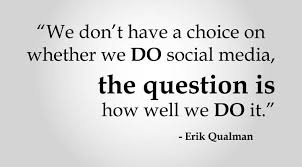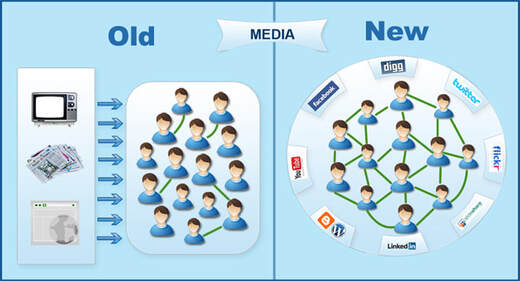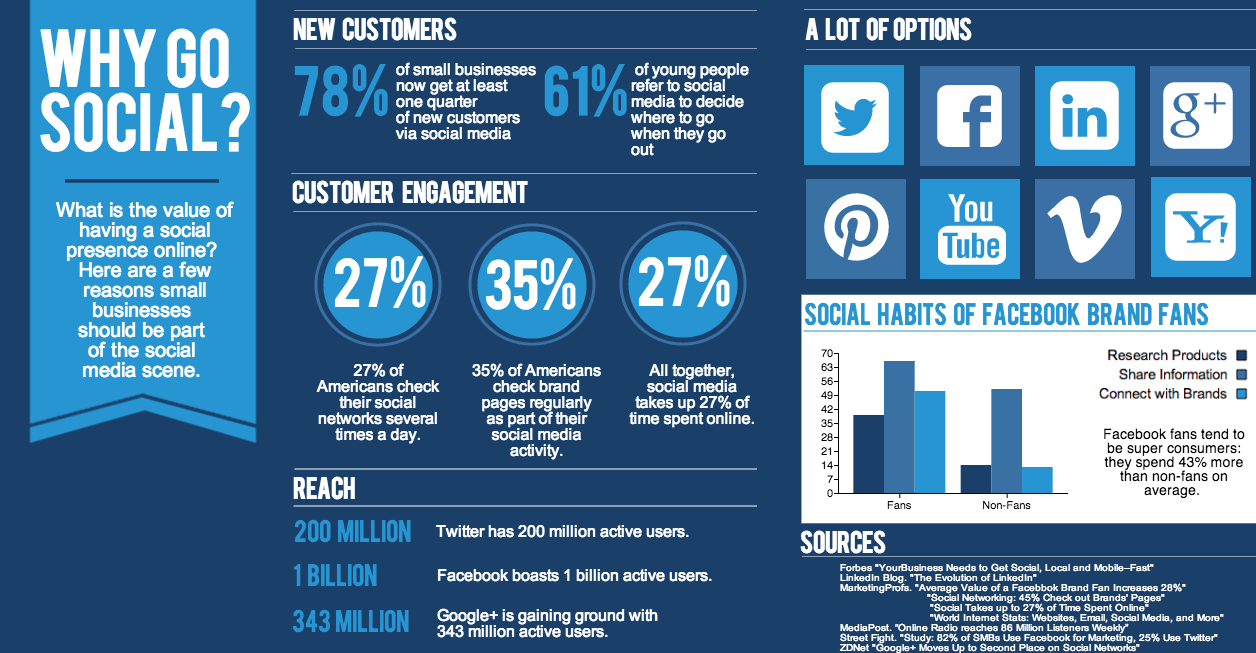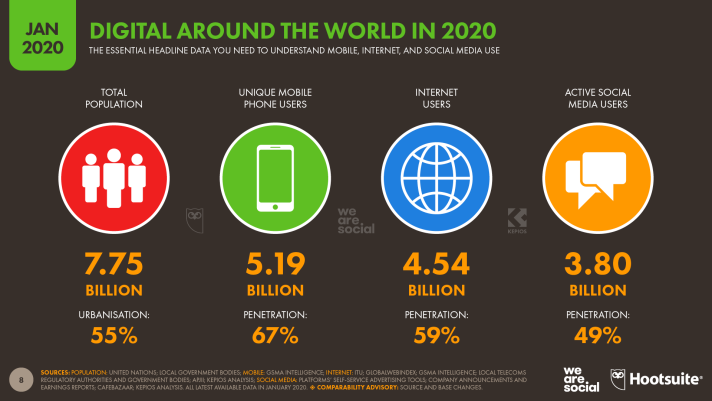Introduction to Social Media Marketing

The use of social media is no longer optional for marketers. Customers are online interacting on social channels with their friends, colleagues, and other brands looking for knowledge, entertainment, and recommendations. If your business does not provide for these customers you will likely lose them to your competition.
Social Media Marketing (SMM) is the use of social networks to reach new customers, engage with existing customers, share content, and promote a mission and vision. There is less advertising and promotion in SMM and more content and engagement. The general rule in social media marketing is only 20% is selling a product or service, 80% is finding ways to provide for an audience.
Social Media Marketing (SMM) is the use of social networks to reach new customers, engage with existing customers, share content, and promote a mission and vision. There is less advertising and promotion in SMM and more content and engagement. The general rule in social media marketing is only 20% is selling a product or service, 80% is finding ways to provide for an audience.
|
Benefits of Social Media Marketing
|
Different Types of Social Media Networks
1. Social Networks: Facebook, Twitter, LinkedIn
Social networks are used by individuals and businesses on the web. For businesses these sites help with branding, social awareness, relationship building, customer service, lead generation, and conversion. They encourage people to interact online, share information and create relationships. Offering both paid and organic marketing strategies.
2. Media Sharing Networks: Instagram, Snapchat, YouTube
Media sharing sites are used to find and share photographs, live video, video and other kinds of media on the web. For businesses they help with brand building, lead generation, targeting and so on. They give individuals and brands a place to discover and share media to a targeted audience.
Note - Social Networks and Media Sharing sites are becoming very similar. Nowadays, many features are found on both types of social media networks.
3. Discussion Forums: Reddit, Quora, Digg
Discussion Forums are used for finding, sharing, and discussing different kinds of information, opinions, and news. They help businesses by being a resource providing information, and research. These forums are the oldest ways of sharing online. Before the popular Social Media Platforms like Facebook, these sites were the places where professionals, experts and enthusiasts used to connect on a variety of topics.
4. Bookmarking & Content Curation Networks: Feedly, Pinterest, Flipboard
Bookmarking will help you find out, share, discuss and save a variety of content and media that are in the news and trending. These platforms offer convenient ways to find content online. They are very helpful in directing brand awareness for your business and generate website traffic and customer engagement.
5. Consumer Review Networks: Yelp, Zomato, TripAdvisor
Customer review networks help find out, share and review different information about a variety of products, services or brands. When a business has positive reviews on these networks, their claims turn more credible because reviews on these networks act as Social Proof. For running a successful Social Media Marketing Campaigns, it is very important for today’s businesses to have positive reviews on these sites.
6. Blogging & Publishing Networks: WordPress, Tumblr, Medium
You should choose this type of Social Media networks for publishing, and discovering other content on the web. They are also great ways to become known as an expert in your field by publishing your own content in a blog or article. WordPress and Blogger are the traditional blogging platforms while Tumblr (micro-blogging service) and Medium (Social Publishing Platform) is a blogging and publishing networks.
7. Social Shopping Networks: Polyvore, Etsy, Fancy
Social shopping provides a platform for selling products and demonstrating the latest trends in a market.
Businesses can use such types of Social Media Platforms for creating brand awareness, boosting engagement, and selling products on some new and effective platforms. These channels transform e-commerce by making them more engaging via some interesting social elements. To use these networks effectively you should create a site that integrates shopping experience with social experience.
1. Social Networks: Facebook, Twitter, LinkedIn
Social networks are used by individuals and businesses on the web. For businesses these sites help with branding, social awareness, relationship building, customer service, lead generation, and conversion. They encourage people to interact online, share information and create relationships. Offering both paid and organic marketing strategies.
2. Media Sharing Networks: Instagram, Snapchat, YouTube
Media sharing sites are used to find and share photographs, live video, video and other kinds of media on the web. For businesses they help with brand building, lead generation, targeting and so on. They give individuals and brands a place to discover and share media to a targeted audience.
Note - Social Networks and Media Sharing sites are becoming very similar. Nowadays, many features are found on both types of social media networks.
3. Discussion Forums: Reddit, Quora, Digg
Discussion Forums are used for finding, sharing, and discussing different kinds of information, opinions, and news. They help businesses by being a resource providing information, and research. These forums are the oldest ways of sharing online. Before the popular Social Media Platforms like Facebook, these sites were the places where professionals, experts and enthusiasts used to connect on a variety of topics.
4. Bookmarking & Content Curation Networks: Feedly, Pinterest, Flipboard
Bookmarking will help you find out, share, discuss and save a variety of content and media that are in the news and trending. These platforms offer convenient ways to find content online. They are very helpful in directing brand awareness for your business and generate website traffic and customer engagement.
5. Consumer Review Networks: Yelp, Zomato, TripAdvisor
Customer review networks help find out, share and review different information about a variety of products, services or brands. When a business has positive reviews on these networks, their claims turn more credible because reviews on these networks act as Social Proof. For running a successful Social Media Marketing Campaigns, it is very important for today’s businesses to have positive reviews on these sites.
6. Blogging & Publishing Networks: WordPress, Tumblr, Medium
You should choose this type of Social Media networks for publishing, and discovering other content on the web. They are also great ways to become known as an expert in your field by publishing your own content in a blog or article. WordPress and Blogger are the traditional blogging platforms while Tumblr (micro-blogging service) and Medium (Social Publishing Platform) is a blogging and publishing networks.
7. Social Shopping Networks: Polyvore, Etsy, Fancy
Social shopping provides a platform for selling products and demonstrating the latest trends in a market.
Businesses can use such types of Social Media Platforms for creating brand awareness, boosting engagement, and selling products on some new and effective platforms. These channels transform e-commerce by making them more engaging via some interesting social elements. To use these networks effectively you should create a site that integrates shopping experience with social experience.

Differences Between Social Media Marketing and Traditional marketing:
One-way vs. Two-way Conversation - Traditional marketing is one-way communications from brand to customers. Social media offers brand to customer, customer to brand, customer to customer which is highly engaging and promotes word of mouth and immediate feedback. Social media is the only marketing platform that allows you to engage and interact with your consumers. You can build a powerful community online, something that is not possible in traditional marketing.
Convenience - Social Media Marketing is a faster way to promote your brand as compared to the more expensive and time-consuming process of traditional marketing. Social media requires you to set up accounts on various platforms like Instagram, Facebook or LinkedIn, whereas traditional marketing would involve creating more static advertisements and messages.
Data - You can find out exactly how many times your marketing messages are clicked, which web pages are visited, how many impressions you made or how many times your post was shared. On the other hand, it’s not easy to know how many people heard your radio spots or read your newspaper ad.
Targeting - You can target specific audiences on social media using targeting features including location, behaviors, interests, age and many more parameters related to your industry and target audience. With traditional advertising, it’s difficult to target people who are actually interested in your business.
One-way vs. Two-way Conversation - Traditional marketing is one-way communications from brand to customers. Social media offers brand to customer, customer to brand, customer to customer which is highly engaging and promotes word of mouth and immediate feedback. Social media is the only marketing platform that allows you to engage and interact with your consumers. You can build a powerful community online, something that is not possible in traditional marketing.
Convenience - Social Media Marketing is a faster way to promote your brand as compared to the more expensive and time-consuming process of traditional marketing. Social media requires you to set up accounts on various platforms like Instagram, Facebook or LinkedIn, whereas traditional marketing would involve creating more static advertisements and messages.
Data - You can find out exactly how many times your marketing messages are clicked, which web pages are visited, how many impressions you made or how many times your post was shared. On the other hand, it’s not easy to know how many people heard your radio spots or read your newspaper ad.
Targeting - You can target specific audiences on social media using targeting features including location, behaviors, interests, age and many more parameters related to your industry and target audience. With traditional advertising, it’s difficult to target people who are actually interested in your business.
From his book, “The New Rules of Marketing and PR” David Meerman Scott stated, “Social networking allows companies to communicate instantly with their existing and potential customers.”
The Evolution of Social Media Marketing
Between 1995 and 2002 is when internet related companies took off and became profitable. Google and Yahoo emerged and helped make it easy for people to search for these companies, SEO (Search Engine Optimization). Then Facebook came along in 2004 and businesses were seeing their customers spending time online. Digital Marketing strategies became a key technique for businesses to find customers. This led to the concept of Web 2.0, which described an accessible, interactive internet. Web 2.0 is when the internet became a place to go shopping and communicate with each other.

Marketing on Social Media can be Paid or Organic
Organic Social Media Marketing takes advantage of the free parts of a social media platform such as sharing images, videos, posting information and engaging in conversation. Business can use this to build relationships, provide information or direct consumers to their website. These are organic types of marketing because they are provided at no cost to a business.
Organic Social Media Best Practices
Paid Social Media Marketing is paid advertising that occurs in social networks. Businesses pay the social media platform to show images, videos, or other ads to a targeted audience.
Paid Social Media Best Practices
Organic Social Media Marketing takes advantage of the free parts of a social media platform such as sharing images, videos, posting information and engaging in conversation. Business can use this to build relationships, provide information or direct consumers to their website. These are organic types of marketing because they are provided at no cost to a business.
Organic Social Media Best Practices
- Understand your audience. While this activity may fall into the ‘obvious’ bucket, so many organizations fail to take the time to understand their target persona. When you understand your audience, it informs which platforms are worth company bandwidth.
- Maximize platform capabilities and best practices. Each social media platform varies by culture, publishing capabilities, engagement features, and available native and third-party management tools. You cannot take a one-size fits all approach to your social media strategy.
- Publish compelling and engaging content. Quality over quantity. Period. Tap into your target persona’s pain points, interests and aspirations to develop a value exchange with them. What can your organization provide that will generate meaningful engagements and compel intended behaviors?
Paid Social Media Marketing is paid advertising that occurs in social networks. Businesses pay the social media platform to show images, videos, or other ads to a targeted audience.
Paid Social Media Best Practices
- Utilize tracking and insight pixels. Once the paid social campaign platforms are identified, it’s time to leverage pixels, or web snippets of code, to integrate platform tracking with web analytics. This enables the ability to better understand campaign performance and make ongoing optimizations.
- Understand advanced targeting. Each social platform offers the same general targeting categories, but where they vary is demographic and interest-based targeting. While your target audience might be active on one platform, targeting them there may not be feasible or cost effective.
Best Practices for a Social Media Marketer
1. Take the time to develop a marketing strategy with a detailed target audience. Inconsistent posting and advertising will not produce desired results. Putting the planning effort upfront will save you time and money in the future.
- 2. Do not oversell your product or service. Social media marketing is more about providing content and engaging with your audience. The general rule is 80% content, 20% selling.
- 3. Be present on social media and in your personal profiles and business pages. Keep your profiles up to date and respond to your audience quickly. For a social media strategy to work you need to constantly engage and be present online.
- 4. Find ways to stay on top of trends and be willing to adjust as social media changes constantly
- Stay authentic to your brand. Create a brand voice and tone that you will stick to in your marketing. Do not over promise be transparent.
Build Connections with Caution
There are many ways to engage on social media and with this comes risks. It's essential to proceed with caution. Keep in mind that not everyone who shows up on a social media website is who he or she claims to be. Exercise caution and closely monitor your personal information any time you engage in social networking activities regardless of what kind of social platforms you are using. Reading on how to stay safe while using social media.
Build Connections with Caution
There are many ways to engage on social media and with this comes risks. It's essential to proceed with caution. Keep in mind that not everyone who shows up on a social media website is who he or she claims to be. Exercise caution and closely monitor your personal information any time you engage in social networking activities regardless of what kind of social platforms you are using. Reading on how to stay safe while using social media.
Source - https://datareportal.com/reports/digital-2020-global-digital-overview


